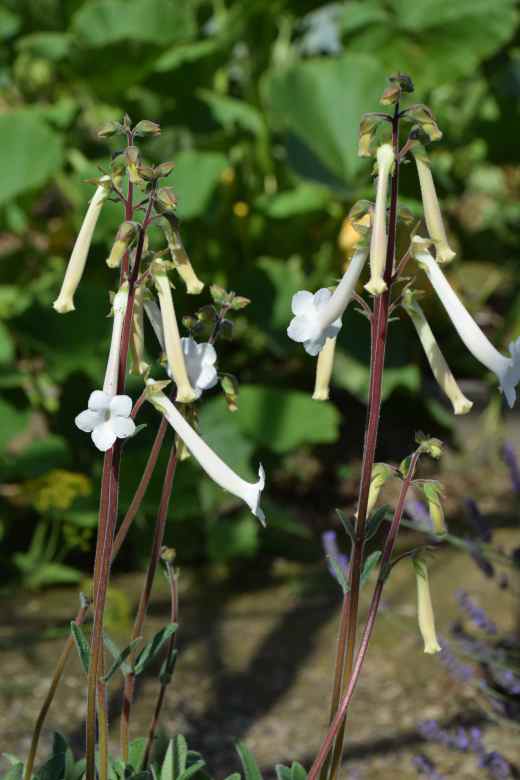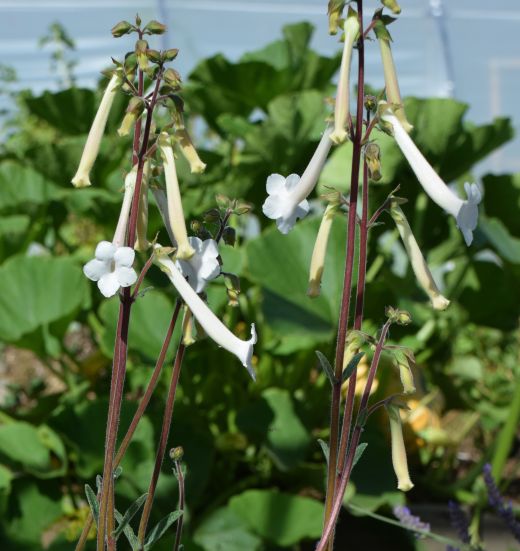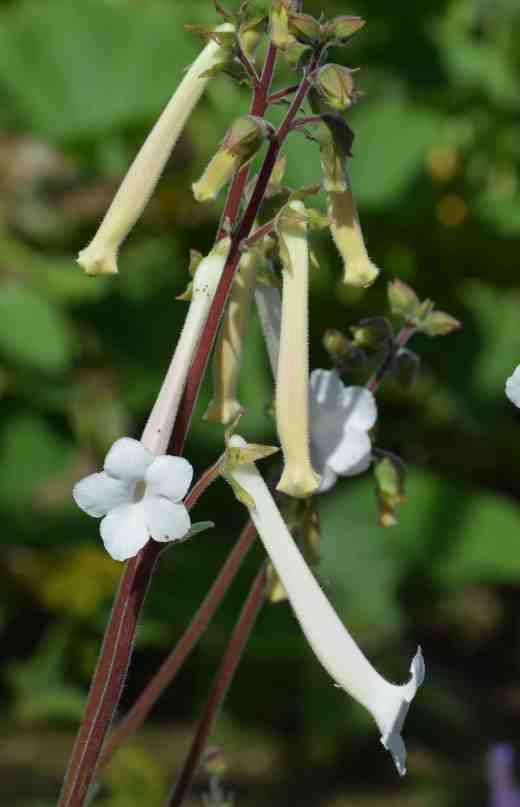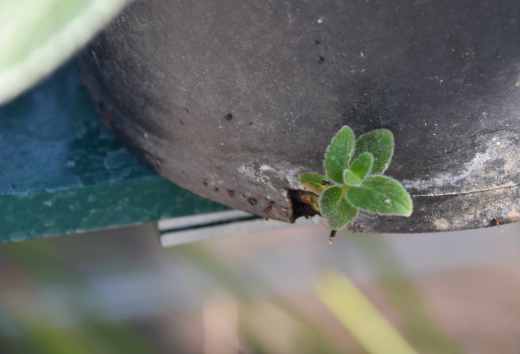A little triumph: Sinningia tubiflora
There are thousands of plants I would like to grow. Most are either impossible to get or need very specific conditions. I can dream of growing these but the reality is unlikely. One family that I adore but generally needs more warmth than I can provide is the Gesneriaceae. If I could afford to heat a large greenhouse I would be happy to potter tirelessly among these varied and beautiful plants. Few of them are hardy (ramonda being an exception) but some, such as streptocarpus (replacing African Violets) are popular houseplants and achimenes deserve greater popularity.
Sinningia is a genus that is barely known, though Sinningia speciosa is often seen and grown under the common name of Gloxinia. There are 70-odd species in the genus, mostly found in Brazil, in various habitats and there is a wide variation in the plants, though most are tuberous. Inexplicably I have yet to post about my S. leucotricha, even though I have had the plant for 20 years and I love its quirkiness, with a large, round tuber at ground level and a stem with four slky, silver leaves and a crown of tubular, red flowers. Perhaps another day.
The one that I have really wanted to try is S. tubiflora. This too is tuberous but produces a cluster of tubers and a plant soon becomes a clump of upright stems with rather fleshy, dark green leaves, covered in grey, coarse hairs and slender stems with pairs of pure white, long-tubed, fragrant flowers. It is ‘almost’ hardy but has a reputation for being difficult to flower.
So I am delighted to announce that, in the first year in my care, my plant is blooming – and how!

The reason I am so happy is that it can sometimes be tricky to bloom. The problem seems to be that plants are too warm in winter or too shady or dry in summer. All I can do is say what I did and hope that it helps.
The pot with a clump of tubers arrived in October 2020. This plant is borderline-hardy, apparently surviving -6c if dry. The tubers are fairly near the surface so a mulch would help keep it alive but I think a gravel mulch would be better than something organic. I will experiment with it outside in future years when I have more stock!
I did not succumb to my usual temptation to split the tubers but kept the pot, as it was, in the cold polytunnel all winter, covering the pot with straw in very cold weather. It possibly got close to freezing but it did not get frozen. In spring I potted the whole 9cm potful into a larger pot with a mix of loam-based compost and multipurpose compost. As growth started I kept the plant moist and through summer it has been well watered and given occasional, general-purpose, high potash feed. It has been in full light in the greenhouse since May. I have kept the leaves dry in case they marked – they are hairy.

More than a month ago it was clear that some of the main shoots were showing flower buds. Now these have extended to about 45cm with flowers in pairs along their length, with four, six or eight blooms per stem. The flowers have a tube about 8cm long and a ‘face’ of five, pure white lobes. One of the great attractions of the plant is that the flowers are fragrant. But like many white flowers the scent is strongest at night. So I brought the pot into the house to better appreciate the scent. And that has been slightly disappointing.
Descriptions usually imply that the scent is strong. I always feel that I have a good sense of smell but when I sniff these blooms I feel that I have some receptors missing! I sniff and try hard, but I really can’t detect the fragrance that I expect. Descriptions usually say it is lemony or that it smells of ‘Fruit loops’ – not that have ever eaten them! There is a delicate lemon scent and something sweet that I just can’t identify. I feel sad about this but, there is a smell and the flowers are pretty anyway. It was in the greenhouse with two pots of acidanthera and these little flowers stood no chance of competing with those – which can be detected metres away.

So I am not disappointed and I feel happy that I have done things right by it, so far. My plan is to detatch a few tubers and grow them on to plant outside. I think that the protection of the house wall may suit them. I plan to plant lavender here and I think the two may get on well. But it is only an idea that is forming in my mind. Small shoots are growing out of the drainage holes in the pot so I think I can detach some tubers without disturbing the whole pot.

Sinningia tubiflora is native to Argentina, Paraguay and Uruguay.
Much of my success is probably down to getting a solid pot full of tubers to start with, rather than a couple of dried tubers. I have Farmyard Nurseries to thank for that – I have mentioned them before. They are in the UK so can only deliver to the UK thanks to Brexit.
Update May 2024
I need to add to these comments. Although I was not initially impressed with the fragrance I can report that it is indeed quite strong. I gave a flowering potful of plants to a friend and she was enchanted by it. It is usually reported that plants do not flower well if the tubers are disturbed but I have been repotting in spring, because the tubers increase well, and they flower OK. It produces tubers of various sizes and stolons that wrap around the edge of the pot. I overwinter the pots of tubers in the cold greenhouse with no difficulty but if water drips on the pot and the compost is not completely dry, the tubers rot. So winter dryness seems essential. I put a potful out last summer and I do not expect any growth this year.
A great success and a beautiful plant.
Thank you 🙂
piękna 🙂 Pozdrawiam serdecznie 🙂
Dziękuję
Już sobie taką kupiłam, cebulki- zobaczymy, co z nich wyrośnie 🙂 Oby nie szczypior :))… :((